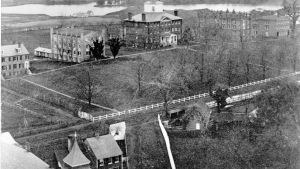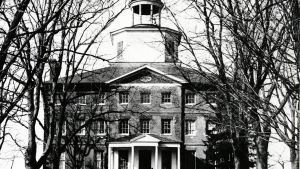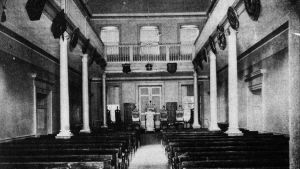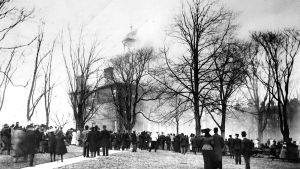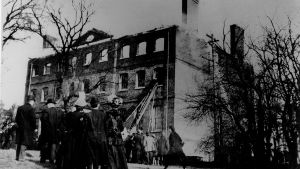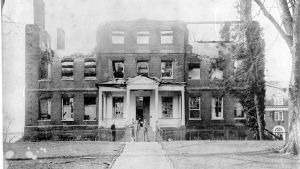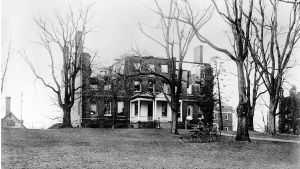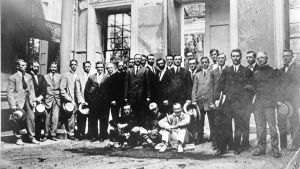ANNAPOLIS—On Saturday, February 20, 1909, a fire engulfed McDowell Hall and nearly burned the historic center of St. John’s College to the ground.

The disastrous event happened as St. John’s was preparing for the 125th anniversary of its charter. The college was in the midst of a building campaign when, according to reports, faulty wiring under the octagon ignited in the top story of McDowell Hall’s roof.
Then-President Thomas Fell had left the building for his dining hour when shortly after his secretary came and told him that McDowell Hall was on fire.
“I returned to the hall and saw a blaze leaping from the roof above my office. It seemed less than a minute before flames began to appear all over the roof,” Fell recounted to the Baltimore American, which with the Baltimore Sun had extensive accounts of the blaze and its aftermath.
Though many students were away for holiday, those who remained were eager to help fight the fire. They formed a bucket brigade while Fell telephoned the city and Naval Academy for aid. When the flames and smoke beat the students back, they resolved to save the building’s contents. Fell and other administrators—including Lieutenant Edmund Iglehart, after whom the gymnasium then under construction was named—broke the boys into squads to divvy up the work.
“The boys worked manfully and heroically,” Fell said. “They ruined their suits of clothing to save the building and its contents.”
Some of the ammunition in the basement—the college was at that time a military academy—was not removed in time. According to the Sun, “as the heat grew in intensity, many of the cartridges exploded and for several minutes there was a continuous round of explosions.”
“Scarcely 10 minutes after the fire started, the large frame cupola, which towered about 40 feet over the center of the building, a seething mass of flames, swayed and tottered, and fell with a crash, and this helped to envelop the entire structure in the flames that were destined to destroy it.”
The building’s tall walls were a serious impediment to firefighting efforts. Firemen and midshipmen worked to douse the flames, but short ladders and intense heat prevented their success. Firemen and midshipmen, the Sun reported, “finally climbed into the large shade trees that surrounded the building. Lines of hose were then extended to the men in the trees, and it was in this manner that the most effective work was done.”
“With the broad tongue of flames leaping more than 50 feet and driven by the wind, the fire could be seen from all parts of the city and the adjoining countryside, and hundreds of people were attracted.”
Though their efforts saved the surrounding buildings, much of McDowell Hall was destroyed. No one was injured, according to the 1910 Rat-Tat (the college yearbook).
“The upper two floors were entirely lost, and much of the first floor was ruined by falling debris and water,” wrote John Christensen in his book on McDowell Hall. “The thick masonry walls, however, were largely intact though badly cracked, and considerable portions of the first floor rear and the basement were preserved, thanks to the prevailing winds.”
In the aftermath of the blaze, discussion began immediately about whether to restore McDowell Hall to its former glory or to demolish it and erect a more modern structure in its place. Read the story of what happened to the historic building.
—Brady Lee (AGI14)
9 photos
